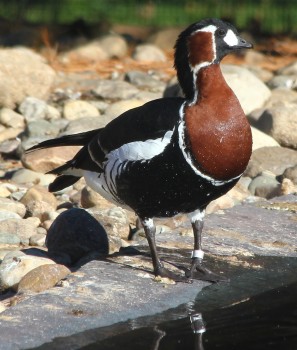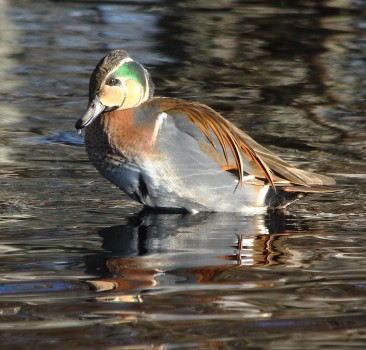
Red-breasted Goose
I’ve been a birder for as long as I can remember. My ability to get out sometimes comes in fits and starts, but birding has always been an integral part of me—like my lungs or heart, an essential piece of who I am, the birds as necessary to my survival. Nothing moves me like grabbing the binoculars and getting into the field, seeing birds living wild within their natural environments. Of course, I also love aviaries and zoos, provided the birds have ample room to move—to wander, swim, fly, to live in a manner that allows them to express, at least in part, the true nature of their being. When I’ve encountered birds held in facilities designed with respect and concern for their welfare, they’ve always been active, healthy, and given the highest level of care. And captive settings can play a vital role in education and conservation: they’re the only venue for many people to see and learn about some of the world’s exotic birds, and in times of need, they can be critical resources for breeding and reintroduction programs—sometimes serving as the last line of defense for species on the edge.
But I’d always drawn a line between wild and captive birds: in my mind, seeing captives didn’t count, they weren’t real sightings. And from a certain point of view, they’re not: you can’t add captive birds to your life list (listing isn’t the only measure by any means, but that’s a discussion for another time), and so they take on second-class status, as if they’re less important and somehow less real. I never spent much time photographing them, and if I did, I didn’t often share them with others. With so many photos of wild birds, what was the point?

Baikal Teal
It sounds trite to say that I’ve grown wiser with the passing of the years, but it’s a fitting truism in this case. Viewing the world through such a narrow perspective closed me off to really appreciating the full diversity of magnificent creatures that share the planet with us. More significantly—and quite distressingly, once I recognized it—it’s utterly disrespectful, and cheapens the lives of the birds who, through no fault of their own, find themselves living outside their wild homes. The birds are no less beautiful, fascinating, or valid for being captive, and they’re equally deserving of our respect and our care. They are, after all, living, breathing creatures, wonderful to behold.
It was in this spirit that my son and I recently traveled to a small town west of Hartford to visit the birds of the Livingston Ripley Waterfowl Conservancy. Based in Litchfield, Connecticut, the Conservancy reached its current incarnation in 2007, when the Livingston Ripley Waterfowl Sanctuary changed its name to the one it bears today. Prior to that, it was known as the Kilvarock Foundation, a non-profit organization launched in 1985 and dedicated to the conservation of captive waterfowl. Kilvarock, in turn, evolved out of the private waterfowl collection of Dr. Dillon Ripley and his wife, Mary Livingston Ripley—a collection Ripley started himself in the 1920s.

Hawaiian Goose (Nene)
Though the Conservancy’s changed its name over the years, it’s been steadfast and unwavering in its mission to conserve waterfowl and wetlands habitat through research, education, and direct action. Consider Hawaii’s native goose, the Nene. By the early ‘60s, the Nene was in real trouble, staring into extinction’s gaping maw. At the time, the number of North Americans raising these birds was exactly two: Dr. and Mrs. Ripley. They sent a small flock to Hawaii to join another group of birds raised in England by Peter Scott’s Wildfowl and Wetlands Trust. Both groups were released in Maui and they, along with Hawaii’s few remaining wild Nenes, began to rebuild the population. By the late 1960s, the population had increased tenfold. Reintroduction was a success—thanks in no small part to the birds raised by the Ripleys half a world away.
There is perhaps no better testament to Ripley’s founding vision, and it’s a credit to the current Board and staff that they uphold the tradition of conservation begun by Dr. Ripley and are supremely dedicated to carrying his vision forward. You don’t need to speak to anyone to realize this, all you have to do is look around. The grounds are beautiful, the aviaries and enclosures are spacious, spotless, and well maintained, and most importantly, the birds are healthy, active, and extremely well cared for.

Mandarin Duck
And they’re captivating. Initially, I was most excited about seeing the Red-breasted Geese, absolutely beautiful and charming birds found in extreme northern Europe and Asia. They’re one of my favorite geese, but I’d only ever seen them in photos, and don’t have any travel plans that would take me anywhere near their wild homes, so this was a special treat. I quickly fell in love with them, and could easily have spent the balance of my time in their company. The Conservancy had much to offer, though, and as my son and I set about exploring the grounds, we found ourselves awed by the spectacle of waterfowl around us. Its collection is extraordinary: Mandarin Ducks from Asia, Hawaiian Nenes, the New Zealand Scaup, Alaskan Spectacled Eiders, Magpie Geese, Screamers, Cuban Whistling Ducks, Baikal and Silver Teals, Smew, Whooper Swans and more besides—an overwhelming display of avian splendor decked in their seasonal finery, a stunning array of colors and patterns laid out before us in a visual banquet, each encounter a new opportunity for love at first sight.
We spent almost four hours at the Conservancy and could easily have stayed longer, but the light was fading and it was near closing time. Reluctantly, we bid farewell to the geese, ducks, teals, and all the multitude of birds who call the Conservancy home. And we took our leave of the staff and volunteers who had been on-hand all day answering questions, leading small tours, and taking care of their charges, the marvelous birds. We’d watched them work and spoken to them on and off throughout our visit, and it was clear that they considered this far more than a job: It was a responsibility, but one they took on willingly, gladly, and joyfully. It wasn’t just that they loved their work (which, to a person, they did), it was that they truly cared for the birds, and approached them with respect, with humility, and with great love. When we’re confronted with stories of environmental destruction almost daily, being in the presence of such genuine affection and concern for the health of these birds and the wild lands in which they live was profoundly moving, and provided a much-needed glimmer of light in the darkness. Those few precious hours we spent at the LRWC left me with a renewed sense of purpose and hope. All is not yet lost, there are people doing good, important wok. There are people who care. As for the birds themselves—those spectacular, captivating birds—I will never forget the time I shared with them, the spiritual nourishment they provided, or the lesson they taught me, that sometimes the deepest connection to wildest Nature can be found in the gaze of a captive bird.
To learn more about the Livingston Ripley Waterfowl Conservancy, you can visit its website here.

Spectacled Eider
